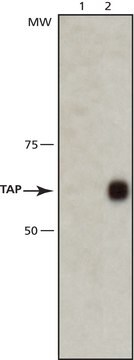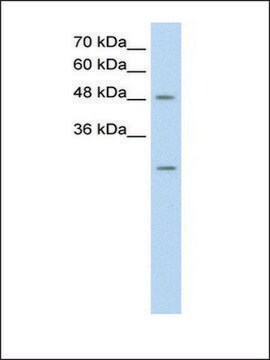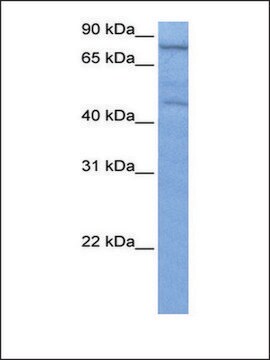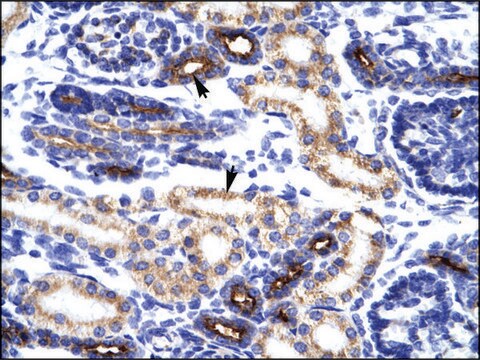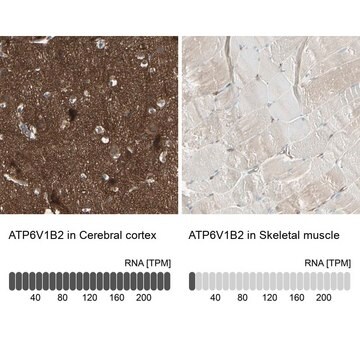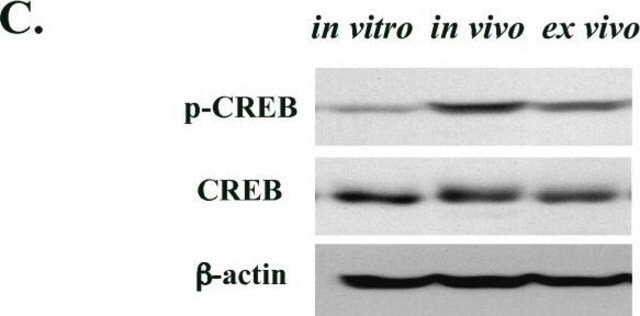Opis ogólny
Jądrowy czynnik eksportu RNA 1 (NXF1, TAP) to jądrowe białko eksportera RNA, które zawiera niekanoniczną domenę wiążącą RNA typu RNP (RBD), 4 powtórzenia bogate w leucynę (LRR), domenę podobną do jądrowego czynnika transportowego 2 (NTF2), która umożliwia heterodimeryzację z białkiem eksportowym-1 związanym z NTF2 (NXT1) oraz domenę związaną z ubikwityną, która pośredniczy w interakcjach z nukleoporynami. Jądrowy czynnik eksportu RNA 1 eksportuje poli(A)+RNA z jądra do cytoplazmy.
Specyficzność
Przeciwciało poliklonalne anty-NXF1 reaguje z białkami jądrowego czynnika eksportu RNA 1 psów, myszy, szczurów, ludzi i bydła.
Immunogen
Syntetyczny peptyd skierowany na region N-końcowy ludzkiego NXF1
Zastosowanie
Przeciwciało poliklonalne anty-NXF1 jest stosowane do znakowania białka jądrowego czynnika eksportu RNA 1 w celu wykrywania i oznaczania ilościowego metodą Western blotting oraz w osoczu techniką immunohistochemiczną (IHC). Jest stosowane jako sonda do określania roli jądrowego czynnika eksportu RNA 1 w eksporcie jądrowym poli-A-RNA.
Działania biochem./fizjol.
NXF1 jest jednym z członków rodziny jądrowych czynników eksportu RNA. Wspólnymi cechami domenowymi tej rodziny są niekanoniczna domena wiążąca RNA typu RNP (RBD), 4 powtórzenia bogate w leucynę (LRR), domena podobna do jądrowego czynnika transportowego 2 (NTF2), która umożliwia heterodimeryzację z białkiem eksportowym-1 związanym z NTF2 (NXT1) oraz domena związana z ubikwityną, która pośredniczy w interakcjach z nukleoporynami. Domeny LRR i podobne do NTF2 są wymagane do aktywności eksportowej. NXF1 przemieszcza się między jądrem a cytoplazmą i wiąże się in vivo z poli(A)+ RNA. NXF1 przezwycięża blokadę eksportu mRNA spowodowaną obecnością nasyconych ilości CTE (konstytutywnego elementu transportowego) RNA retrowirusów typu D. Gen ten jest jednym z członków rodziny genów jądrowego czynnika eksportu RNA. Wspólne cechy domeny tej rodziny to niekanoniczna domena wiążąca RNA typu RNP (RBD), 4 powtórzenia bogate w leucynę (LRR), domena podobna do czynnika transportu jądrowego 2 (NTF2), która umożliwia heterodimeryzację z białkiem eksportowym-1 związanym z NTF2 (NXT1) oraz domena związana z ubikwityną, która pośredniczy w interakcjach z nukleoporynami. Domeny LRR i podobne do NTF2 są wymagane do aktywności eksportowej. Alternatywny splicing wydaje się być powszechnym mechanizmem w tej rodzinie genów. Kodowane białko tego genu przemieszcza się między jądrem a cytoplazmą i wiąże się in vivo z poli(A)+ RNA. Jest to kręgowy homolog drożdżowego białka Mex67p. Kodowane białko przezwycięża blok eksportu mRNA spowodowany obecnością nasycających ilości CTE (konstytutywnego elementu transportowego) RNA retrowirusów typu D. Gen ten jest jednym z członków rodziny genów jądrowego czynnika eksportu RNA. Wspólne cechy domeny tej rodziny to niekanoniczna domena wiążąca RNA typu RNP (RBD), 4 powtórzenia bogate w leucynę (LRR), domena podobna do czynnika transportu jądrowego 2 (NTF2), która umożliwia heterodimeryzację z białkiem eksportowym-1 związanym z NTF2 (NXT1) oraz domena związana z ubikwityną, która pośredniczy w interakcjach z nukleoporynami. Domeny LRR i podobne do NTF2 są wymagane do aktywności eksportowej. Alternatywny splicing wydaje się być powszechnym mechanizmem w tej rodzinie genów. Kodowane białko tego genu przemieszcza się między jądrem a cytoplazmą i wiąże się in vivo z poli(A)+ RNA. Jest to kręgowy homolog drożdżowego białka Mex67p. Kodowane białko pokonuje blok eksportu mRNA spowodowany obecnością nasycających ilości CTE (konstytutywnego elementu transportowego) RNA retrowirusów typu D.
Sekwencja
Syntetyczny peptyd zlokalizowany w następującym regionie: RPNRRGDTWHDRDRIHVTVRRDRAPPERGGAGTSQDGTSKNWFKITIPYG
Postać fizyczna
Oczyszczone przeciwciało dostarczane w 1x buforze PBS z 0,09% (w/v) azydkiem sodu i 2% sacharozą.
Oświadczenie o zrzeczeniu się odpowiedzialności
O ile nie określono inaczej w naszym katalogu lub innej dokumentacji firmy dołączonej do produktu(-ów), nasze produkty są przeznaczone wyłącznie do użytku badawczego i nie mogą być wykorzystywane do żadnych innych celów, w tym między innymi do nieautoryzowanych zastosowań komercyjnych, zastosowań diagnostycznych in vitro, zastosowań terapeutycznych ex vivo lub in vivo lub jakiegokolwiek rodzaju konsumpcji lub zastosowania u ludzi lub zwierząt.
Ta strona może zawierać tekst przetłumaczony maszynowo.
